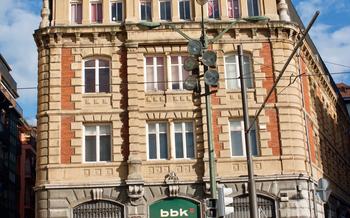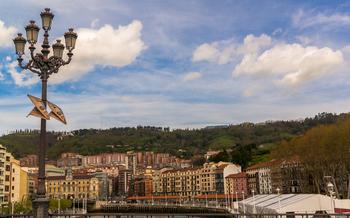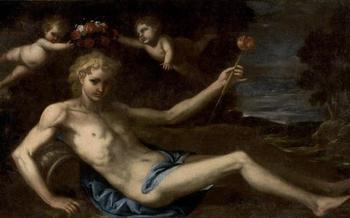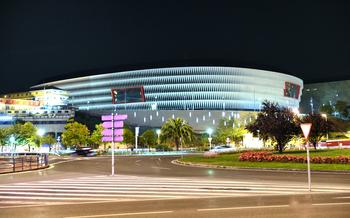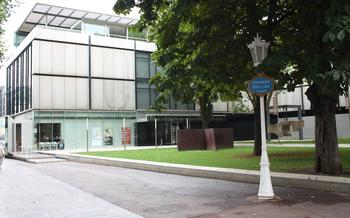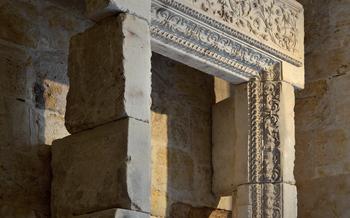
Museum of Sacred Art (Museo de Arte Sacro)
- The Museum of Sacred Art (Museo de Arte Sacro)
- Exploring the Museum's Galleries
- Medieval Art at the Museum
- Renaissance and Baroque Art at the Museum
- The Sala Capitular
- The Sacristy
- Temporary Exhibitions and Events
- Practical Information for Visitors
- Getting to the Museum
- Hours of Operation and Closures
- Combining Your Visit with Other Attractions
- Tips for Photography Enthusiasts
- Unveiling the Museum's Hidden Gems
- Shopping at the Museum Store
- Insider Tip: Discovering Bilbao's Hidden Art Gems
The Museum of Sacred Art (Museo de Arte Sacro)
The Museum of Sacred Art in Bilbao is a treasure trove of religious art and artifacts, offering a comprehensive journey through the history of Christianity in the Basque Country. Housed in the historic Palacio Episcopal, the museum's collection spans from the Middle Ages to the Baroque period, showcasing masterpieces from some of the region's most renowned artists.
Located in the heart of Bilbao's old town, the Museum of Sacred Art is easily accessible by foot or public transportation. The museum's address is Plaza Nueva, 4, 48005 Bilbao, Bizkaia, Spain, and its phone number is +34 944 15 85 4
Among the highlights of the collection are the Romanesque crucifix from the 12th century, a masterpiece of medieval sculpture; the Gothic altarpiece of San Andrés, with its intricate carvings and vibrant colors; and the Renaissance painting of the Virgin Mary by Juan de Flandes, a Flemish artist who left a significant mark on Basque art.
Exploring the Museum's Galleries
The Museum of Sacred Art in Bilbao is a treasure trove of religious art, boasting a diverse collection spanning from the Middle Ages to the Baroque period. As you wander through its galleries, you'll encounter various thematic sections that showcase the evolution of sacred art and its profound impact on Basque culture.
One of the highlights of the museum is the Medieval Art section, where you'll find exquisite examples of Romanesque and Gothic sculptures, paintings, and metalwork. Marvel at the intricate details and symbolism of these artworks, which served as a means of religious education and inspiration for the faithful.
Another must-see section is the Renaissance and Baroque Art gallery, which features masterpieces influenced by the Italian and Flemish masters. Admire the vibrant colors, dramatic compositions, and illusionistic techniques that characterized these periods. Look out for works by renowned artists such as El Greco, Rubens, and Zurbarán, whose paintings and sculptures grace the museum's walls.
To enhance your visit, take advantage of the interactive exhibits and multimedia presentations scattered throughout the museum. These interactive displays provide insightful information about the artworks, their historical context, and the techniques used by the artists. Engage with these interactive elements to gain a deeper understanding and appreciation for the museum's collection.
Medieval Art at the Museum
The Museum of Sacred Art in Bilbao houses a remarkable collection of medieval art, showcasing the evolution of artistic styles and techniques from the Romanesque to the Gothic periods. Notable pieces from this era include intricately carved wooden sculptures, vibrant stained glass windows, and exquisite illuminated manuscripts.
One of the museum's highlights is a stunning Romanesque crucifix from the 12th century, showcasing the expressive and emotional style characteristic of the period. The intricate details and emotive depiction of Christ's suffering captivate visitors with its raw power and artistry.
The Gothic period is represented by a collection of finely crafted altarpieces, featuring elaborate carvings and vibrant colors. The altarpiece of the Virgin Mary, created in the 14th century, stands out for its intricate tracery, graceful figures, and rich symbolism.
Beyond their aesthetic beauty, the medieval artworks at the Museum of Sacred Art offer a glimpse into the religious beliefs, social customs, and artistic traditions of their time. Visitors can explore the symbolism and iconography prevalent in medieval art, gaining a deeper understanding of the cultural and theological context that shaped these masterpieces.
Renaissance and Baroque Art at the Museum
The influence of Italian and Flemish masters is evident in the Renaissance and Baroque artworks housed in the Museum of Sacred Art. These periods witnessed a shift towards a more humanistic approach, with a focus on realism, perspective, and emotional expression.
Among the notable pieces from the Renaissance era is a delicate alabaster sculpture of the Virgin and Child, attributed to the workshop of the renowned Florentine artist Donatello. Its exquisite details and serene expressions exemplify the transition from Gothic to Renaissance styles.
From the Baroque period, visitors can admire the dramatic and dynamic painting "The Martyrdom of San Sebastián" by José de Ribera. The intense colors, theatrical lighting, and contorted figure of the saint convey the emotional intensity characteristic of Baroque art.
Another highlight is the elaborately carved wooden altarpiece by Juan de Ancheta, showcasing intricate scenes from the life of Christ. Its intricate ornamentation and use of perspective create a sense of grandeur and awe.
These Renaissance and Baroque masterpieces, with their diverse influences and artistic innovations, offer a fascinating glimpse into the evolution of sacred art during these pivotal periods.
The Sala Capitular
The Sala Capitular, also known as the Chapter House, holds a significant place within the Museum of Sacred Art. Originally serving as a meeting room for the cathedral's canons, this room exudes a sense of history and grandeur. Its architectural features, including intricate ribbed vaults and delicate tracery, reflect the Gothic style prevalent during its construction.
The Sala Capitular is adorned with a remarkable collection of religious artifacts and paintings. Among the highlights are exquisitely crafted silver reliquaries, which once held the remains of revered saints. The walls are adorned with stunning Flemish tapestries depicting biblical scenes, adding a touch of color and narrative to the room.
One of the most captivating pieces in the Sala Capitular is a 15th-century altarpiece dedicated to Saint Anne. This intricate work of art features a central panel depicting Saint Anne with the Virgin Mary and the infant Jesus. The surrounding panels showcase scenes from the life of Saint Anne, rendered in vivid detail and rich colors.
The Sala Capitular offers visitors a glimpse into the religious and artistic traditions of Bilbao's past. Its well-preserved architecture and carefully curated collection provide a unique and immersive experience for those interested in sacred art and history.
The Sacristy
The sacristy of the Museum of Sacred Art in Bilbao holds a treasure trove of exquisite liturgical vestments and accessories, reflecting the opulence and devotion that characterized religious ceremonies in the past. This sacred space was designed to store and prepare the vestments, vessels, and other items required for Mass and other religious rituals.
The sacristy's collection showcases intricate embroidery, delicate lacework, and gleaming metalwork, all meticulously crafted to adorn priests and other clergy during religious services. Visitors can admire chasubles, dalmatics, and copes adorned with vibrant colors, intricate patterns, and symbolic motifs. These vestments, often made from luxurious fabrics like silk, velvet, and brocade, were adorned with precious metals, gemstones, and pearls, reflecting the importance and reverence accorded to religious rituals.
Among the highlights of the sacristy's collection are the processional crosses, monstrances, and chalices, each a masterpiece of craftsmanship. The processional crosses, carried during religious processions, are adorned with intricate carvings, enamel work, and precious stones, symbolizing the triumph of faith and the crucifixion of Christ. The monstrances, used to display the consecrated host during Eucharistic adoration, are crafted from silver or gold, often featuring intricate filigree work and delicate enamel decoration. The chalices, used for serving wine during communion, are adorned with intricate engravings, repoussé work, and gemstones, symbolizing the preciousness of the blood of Christ.
The sacristy also houses a collection of reliquaries, ornate containers that hold the relics of saints and other holy figures. These reliquaries, made from precious metals and adorned with intricate enamel work, jewels, and carvings, serve as a testament to the veneration of saints and the belief in their intercession.
Temporary Exhibitions and Events
The Museum of Sacred Art in Bilbao is a dynamic institution that hosts a variety of temporary exhibitions and events throughout the year. These exhibitions showcase diverse artistic expressions, historical artifacts, and cultural traditions related to sacred art. Visitors can explore special collections, delve into specific themes, and discover new perspectives on religious art and its significance.
The museum's calendar features a range of events, including guided tours, workshops, lectures, and educational programs. These events provide opportunities for visitors to engage with experts, learn about conservation techniques, and participate in hands-on activities. The museum also collaborates with local artists and organizations to present innovative exhibitions and events that foster dialogue and cultural exchange.
To stay updated on the museum's upcoming exhibitions and events, visitors can check the official website, follow the museum's social media channels, or sign up for the museum's newsletter. The website provides detailed information on exhibition dates, themes, and related events, allowing visitors to plan their visit accordingly.
Practical Information for Visitors
Admission to the Museum of Sacred Art is free of charge for all visitors. Guided tours are available in Spanish, English, and French upon request and subject to availability. Advance booking is recommended to secure a spot.
The museum offers accessibility features for visitors with disabilities, including wheelchair ramps, elevators, and accessible restrooms. Assistance is available upon request.
The museum also provides a variety of educational programs and workshops throughout the year, catering to different age groups and interests. Check the museum's website or inquire at the information desk for current offerings.
Getting to the Museum
The Museum of Sacred Art is conveniently located in the heart of Bilbao's Old Town, making it easily accessible from various parts of the city. If you're starting your journey from the iconic Guggenheim Museum, you can take a leisurely stroll along the picturesque Nervión River for about 20 minutes. Alternatively, you can hop on the metro and alight at the Casco Viejo station, which is just a short walk from the museum. Once you step out of the station, follow the signs or ask a friendly local for directions, and you'll soon find yourself in front of this architectural gem.
For those arriving by car, there are several parking options nearby. The closest parking garage is located on Calle Arenal, just a few minutes away from the museum. You can also find on-street parking in the surrounding streets, but be sure to check the parking regulations carefully to avoid any inconvenience. Once you've parked your vehicle, take a moment to admire the beautiful surroundings before heading into the museum to explore its sacred treasures.
Hours of Operation and Closures
The Museum of Sacred Art in Bilbao adheres to specific hours of operation to ensure optimal visitor experiences and the preservation of its collection. The museum typically opens its doors from Tuesday to Sunday, with varying hours depending on the season. During the summer months (June to September), the museum welcomes visitors from 10:00 AM to 8:00 PM, offering extended hours to accommodate the influx of tourists. For the remainder of the year, the museum maintains its regular hours from 10:00 AM to 7:00 PM.
It is important to note that the museum observes occasional closures for holidays and special events. To avoid any inconvenience, visitors are advised to check the museum's official website or contact them directly for the most up-to-date information regarding closures. This will ensure that you can plan your visit accordingly and make the most of your time exploring the museum's exceptional collection of sacred art.
Combining Your Visit with Other Attractions
Bilbao is a treasure trove of cultural and historical attractions, making it easy to combine your visit to the Museum of Sacred Art with other enriching experiences.
-
Within a short walk from the museum, you can explore the bustling Plaza Nueva, the heart of Bilbao's old town, and marvel at the stunning architecture of the Arriaga Theatre.
-
Art enthusiasts can immerse themselves in the contemporary art scene at the Guggenheim Museum Bilbao, showcasing works by renowned artists like Jeff Koons and Richard Serra.
-
For a taste of maritime history, head to the Bilbao Maritime Museum, where you can learn about the city's shipbuilding industry and its role in Basque maritime exploration.
-
To discover Bilbao's unique architectural heritage, embark on a guided walking tour that takes you past landmarks like the Alhóndiga Bilbao, the former wine warehouse transformed into a cultural center, and the neoclassical City Hall.
-
Plan your visit to coincide with one of Bilbao's many festivals, such as the Aste Nagusia, a week-long celebration featuring concerts, parades, and traditional Basque sports.
With so much to see and do in Bilbao, you can easily create a personalized sightseeing itinerary that caters to your interests and time constraints.
Tips for Photography Enthusiasts
The Museum of Sacred Art offers a treasure trove of opportunities for photography enthusiasts. Whether you're a professional photographer seeking unique shots or an amateur capturing memories of your visit, here are some tips to help you make the most of your experience:
Be Respectful of Other Visitors: Photography is allowed inside the museum, but it's essential to be mindful of other visitors. Avoid blocking their view or using flash photography that might disturb their contemplation of the artworks.
Find the Best Angles and Lighting: The museum's galleries are often dimly lit to preserve the artifacts, so finding the right angle and lighting can be challenging. Look for natural light sources or experiment with different camera settings to capture the best possible images.
Capture the Details: The museum is home to intricate details and hidden symbolism in its artworks. Take your time to zoom in and capture close-ups of these details to fully appreciate the craftsmanship and artistry.
Respect the Museum's Guidelines: Be sure to follow the museum's guidelines regarding photography. Some artifacts may have restrictions on photography, so always check with the museum staff if you're unsure.
Share Your Work: Once you've captured your shots, don't forget to share them with others! Tag the museum on social media or use relevant hashtags to connect with fellow art enthusiasts and showcase your work.
Unveiling the Museum's Hidden Gems
Beyond the renowned masterpieces, the Museum of Sacred Art in Bilbao holds a treasure trove of lesser-known artifacts and intriguing stories waiting to be discovered. One such gem is a small, unassuming painting tucked away in a corner of the Gothic gallery. Depicting a tender scene of the Virgin Mary cradling the infant Jesus, this exquisite work is believed to date back to the 15th century. Its delicate brushstrokes and vibrant colors belie its age, offering a glimpse into the artistic mastery of the era.
Another hidden gem is a collection of intricately carved choir stalls from the 17th century. Intricately adorned with biblical scenes and mythical creatures, these stalls once graced the Cathedral of Bilbao. They were carefully restored and relocated to the museum, where visitors can admire their craftsmanship and marvel at the stories they tell.
For those who seek a deeper connection with the museum's collection, engaging with the knowledgeable staff is highly recommended. They can provide fascinating insights into the symbolism and iconography of the artworks, as well as share anecdotes and stories that bring the pieces to life. Whether it's uncovering the hidden meanings behind a seemingly ordinary object or learning about the historical events that shaped a particular artwork, these interactions can transform a visit into a truly immersive and unforgettable experience.
Shopping at the Museum Store
The Museum of Sacred Art offers a well-stocked store where visitors can find a variety of books, souvenirs, and religious items to commemorate their visit. The selection includes informative publications on the museum's collection, as well as postcards, replicas of religious artifacts, and unique gift items inspired by the museum's artwork.
By making a purchase at the museum store, visitors not only take home a tangible reminder of their experience but also contribute to the museum's mission of preserving and promoting sacred art. The revenue generated from the store helps support the museum's ongoing exhibitions, educational programs, and conservation efforts.
Whether you are looking for a meaningful gift for a loved one, a souvenir to cherish, or a way to show your appreciation for the museum's work, the Museum of Sacred Art store offers a diverse selection of items to suit every taste and budget. Take advantage of this opportunity to bring a piece of Bilbao's rich artistic heritage home with you.
Insider Tip: Discovering Bilbao's Hidden Art Gems
Beyond the Museum of Sacred Art, Bilbao is home to a wealth of hidden art gems waiting to be discovered. Venture off the beaten path to explore lesser-known churches and religious sites that house remarkable religious artwork. The Church of San Antón, tucked away in the old town, boasts a stunning altarpiece by the renowned Basque sculptor and painter, Eduardo Chillida.
For a truly unique experience, seek out the Church of La Encarnación, where you'll find a hidden gem of Gothic architecture. Admire the intricate details of the 15th-century altarpiece, depicting scenes from the life of Christ. These hidden treasures offer a glimpse into Bilbao's rich artistic and cultural heritage, providing a deeper appreciation for the city's sacred art beyond the walls of the museum.
